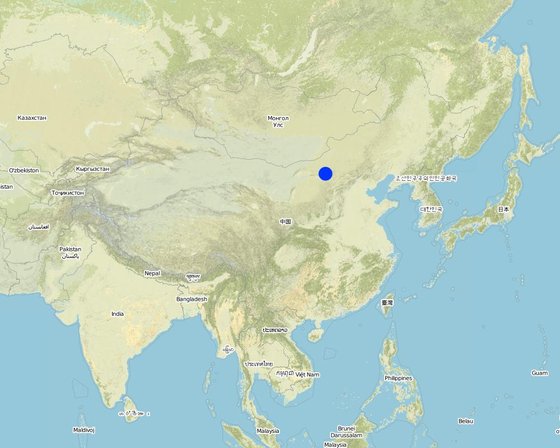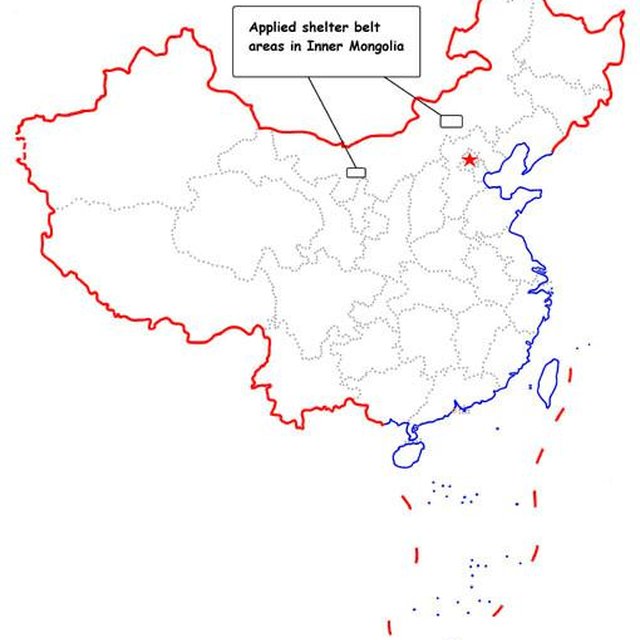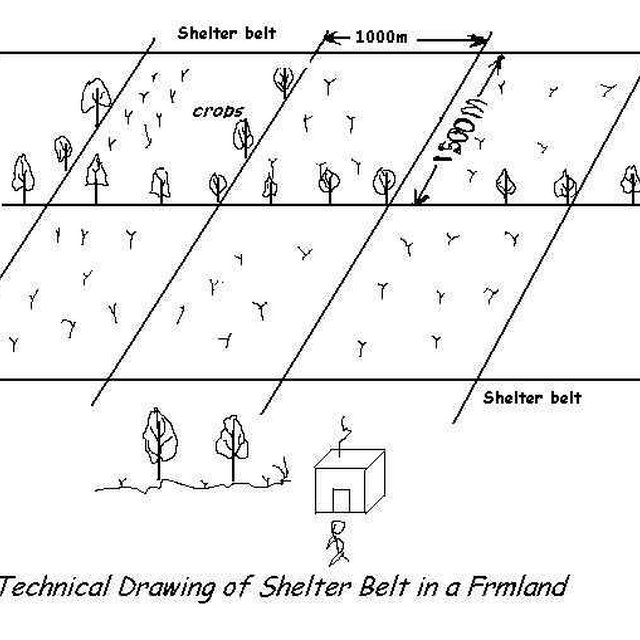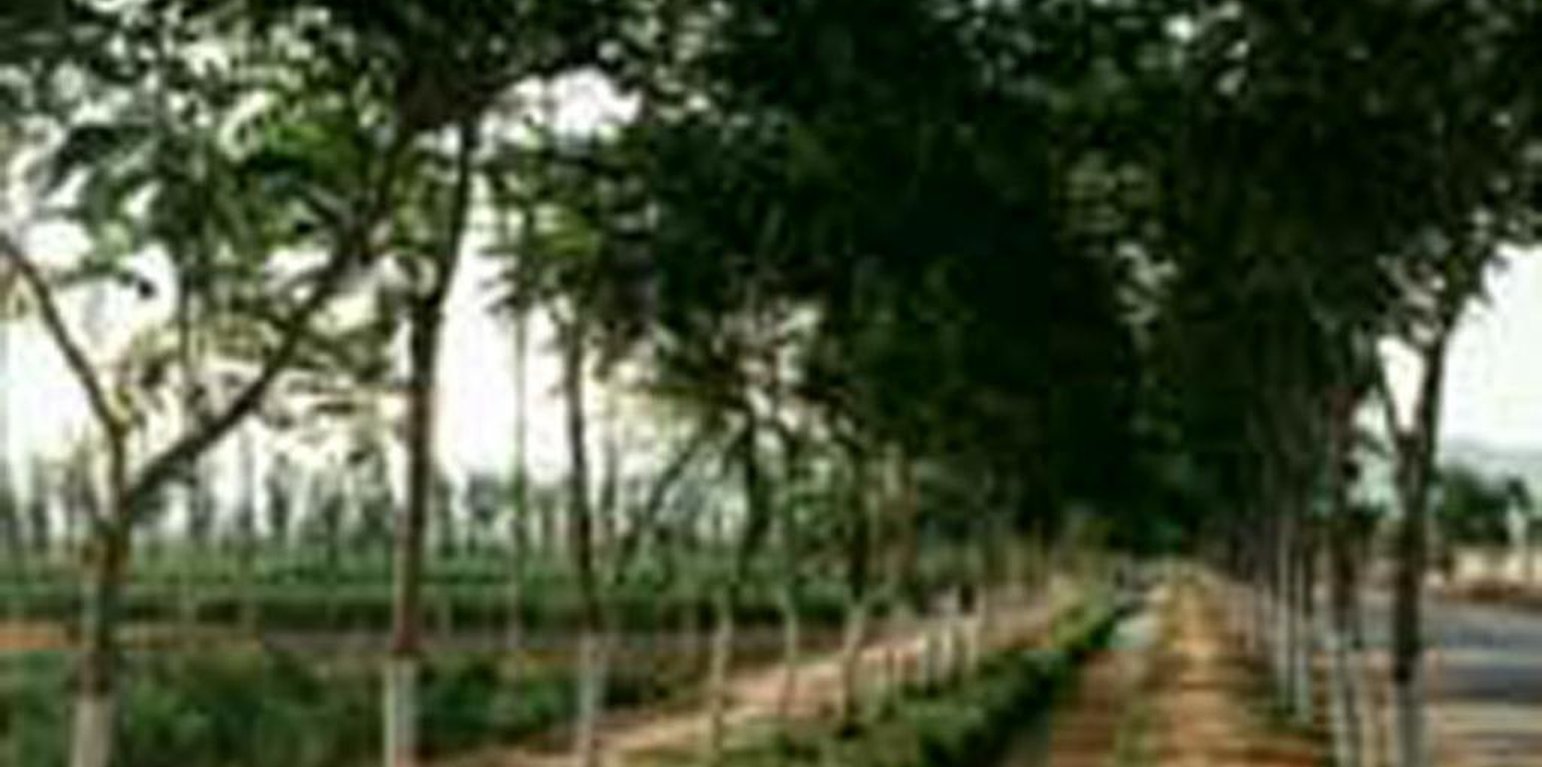Shelter Belt
(ប្រទេសចិន)
ការពណ៌នា
The shelter belt is a strip or a row of trees planted in a farmland as a wind barrier to protect crops and reduce wind erosion.
Aims / objectives: Overall purposes are improving environment, and then realization sustainable development of agriculture. Specific objectives are decreasing wind erosion of cropland, increasing foodstuff production. When this approach is decided to implement, the first things to be done are to investigate natural and social-economic environment. Then scope and stages of implementation are decided by government with provision of capital and policies. After that, the approach need to propagandize to people who live in the project area. To implement this approach step by step, local government and land users play an very important role in implementation of the approach.
ទីតាំង

ទីតាំង: Inner Mongolia, ប្រទេសចិន
ចំណុចយោងភូមិសាស្ត្រនៃទីតាំងជ្រើសរើស
កាលបរិច្ឆេទចាប់ផ្តើម: 1960
ឆ្នាំបញ្ចប់: 1981
ប្រភេទនៃវិធីសាស្ត្រផ្សព្វផ្សាយ
-
ក្រុមប្រពៃណី/ក្រុមជនជាតិភាគតិច
-
អ្នកផ្តួចផ្តើមក្នុងតំបន់/អ្នករុករកឃើញថ្មីៗ
-
ផ្អែកលើគម្រោង/កម្មវិធី

Relative location of the shelter belt application in the Inner Mongolia, China.

Patterns of shelter belt distribution in the farmland
គោលបំណងនៃវិធីសាស្រ្តផ្សព្វផ្សាយនិងបរិស្ថានអំណោយផល
គោលបំណងនៃវិធីសាស្រ្តផ្សព្វផ្សាយ
The Approach focused mainly on SLM with other activities (Modulation of air temperature, purifying air and increasing oxygen.)
The main objectives of the approach were reducing wind speed and keep soil moisture so as to be sustainable development of local land resources.
The SLM Approach addressed the following problems: Serious wind erosion in the farmland, and poor land management.
លក្ខខណ្ឌអំណោយផលដល់ការអនុវត្តបចេ្ចកទេសដែលបានប្រើក្នុងវិធីសាស្រ្តផ្សព្វផ្សាយ
លក្ខខណ្ឌរាងរាំងដល់ការអនុវត្តបចេ្ចកទេសដែលបានប្រើក្នុងវិធីសាស្រ្តផ្សព្វផ្សាយ
-
ភាពអាចរកបាននៃធនធានហិរញ្ញវត្ថុ និងសេវាកម្ម: No enough money
Treatment through the SLM Approach: Raising funds from different level of government
-
ក្របខណ្ឌច្បាប់ (សិទ្ធិកាន់កាប់ដីធ្លី កម្មសិទ្ធីប្រើប្រាស់ដីនិងទឹក): Lack of enforcement of legislation
Treatment through the SLM Approach: Enforcement of legislation
The existing land ownership, land use rights / water rights moderately hindered the approach implementation Persuading land users to accept this SWC approach.
ការចូលរួមនិងតួរនាតីរបស់ភាគីពាក់ព័ន្ធដែលចូលរួម
ភាគីពាក់ព័ន្ធដែលចូលរួមក្នុងវិធីសាស្រ្តផ្សព្វផ្សាយ និងតួរនាទីរបស់គាត់
| តើមានភាគីពាក់ព័ន្ធ/ភ្នាក់ងារអនុវត្តន៍ណាខ្លះដែលបានចូលរួមក្នុងវិធីសាស្ត្រផ្សព្វផ្សាយ? |
សូមបញ្ជាក់ភាគីពាក់ព័ន្ធ |
សូមពណ៌នាតួនាទីរបស់ភាគីពាក់ព័ន្ធ |
| អ្នកប្រើប្រាស់ដីក្នុងតំបន់/សហគមន៍ |
Mongolian, Moslem, Korean minority nationalities, etc
Work equally divided between men and women |
|
| អ្នកឯកទេសគ្រប់គ្រងដីប្រកបដោយចីរភាព/ទីប្រឹក្សាបច្ចេកទេសកសិកម្ម |
A group of national and international specialists have been studying for a long time, and summarized this approach. |
|
| រដ្ឋាភិបាលថ្នាក់ជាតិ (អ្នករៀបចំផែនការ អ្នកសម្រេចចិត្ត) |
The implementing agencies are national government |
|
ការចូលរួមពីអ្នកប្រើប្រាស់ដីឬសហគមមូលដ្ឋានក្នុងតំណាក់កាលផ្សេងគ្នានៃវិធីសាស្រ្តផ្សព្វផ្សាយ
គ្មាន
អសកម្ម
ការគាំទ្រពីខាងក្រៅ
អន្តរកម្ម
គំនិតផ្តួចផ្តើមដោយខ្ឡួនឯង
ការចាប់ផ្តើម/ការលើកទឹកចិត្ត
public meetings; They were involved in approach by public meeting and understood the approach.
ការរៀបចំផែនការ
ublic meetings; They involved approach by public meeting and understand the approach
ការអនុវត្តន៍
casual labour; They increased their income by participating casual labour
ការត្រួតពិនិត្យ និងវាយតម្លៃ
interviews/questionnaires; They pronounced their point of view by interviews or questionnaires
Research
They do not participate in.
ការសម្រេចចិត្តលើការជ្រើសរើសបច្ចេកទេស SLM
ការសម្រេចចិត្តត្រូវបានធ្វើដោយ
-
អ្នកប្រើប្រាស់ដីដោយខ្លួនឯងផ្ទាល់ (គំនិតផ្តួចផ្តើមដោយខ្លួនឯង)
-
អ្នកប្រើប្រាស់ដី ដោយមានការគាំទ្រពីអ្នកជំនាញឯកទេស SLM
-
គ្រប់ភាគីពាក់ព័ន្ធទាំងអស់ដែលជាផ្នែកនៃវិធីសាស្រ្តផ្សព្វផ្សាយដោយមានការចូលរួម
-
អ្នកជំនាញឯកទេស SLM បន្ទាប់ពីបានប្រឹក្សាយោបល់ជាមួយអ្នកប្រើប្រាស់ដី
-
អ្នកជំនាញឯកទេស SLM តែឯង
-
អ្នកនយោបាយ /អ្នកដឹកនាំ
ការសម្រេចចិត្តត្រូវបានធ្វើដោយផ្អែកលើ៖
-
វាយតម្លៃទៅលើចំណេះដឹងស្តីអំពី SLM ដែលបានចងក្រងជាឯកសារបានត្រឹមត្រូវ (ផ្អែកលើភស្តុតាងជាមូលដ្ឋានដើម្បីសម្រេចចិត្ត)
-
លទ្ធផលបានពីការស្រាវជ្រាវ
-
បទពិសោធន៍ និងគំនិតផ្ទាល់ខ្លួន(ពុំមានចងក្រងជាឯកសារ)
ការគាំទ្របច្ចេកទេស ការកសាងសមត្ថភាព និងការគ្រប់គ្រងចំណេះដឹង
សកម្មភាព ឬសេវាកម្មខាងក្រោមបានប្រើជាផ្នែកនៃវិធីសាស្ត្រផ្សព្វផ្សាយ
-
ការកសាងសមត្ថភាព/ បណ្តុះបណ្តាល
-
សេវាផ្តល់ប្រឹក្សាយោបល់
-
ការពង្រឹងសមត្ថភាពស្ថាប័ន (ការអភិរឌ្ឍន៍អង្គភាព)
-
ការត្រួតពិនិត្យ និងវាយតម្លៃ
-
ការស្រាវជ្រាវ
សេវាកម្មប្រឹក្សា
សេវាកម្មប្រឹក្សាត្រូវបានផ្តល់ឱ្យ
-
នៅលើដីរបស់អ្នកប្រើប្រាស់ដី
-
នៅមជ្ឈមណ្ឌលជាអចិន្ត្រៃ
On-the-job, farm visits, demonstration areas; Key elements: Quality of on-the-job, Effect of farm visits, Quality of demonstration areas; 1) Advisory service was carried out through: projects own extension structure and agents 2) Advisory service was carried out through: projects own extension structure and agents; Extension staff: mainly government employees 3) Target groups for extension: technicians/SWC specialists; Activities: Courses and demonstration
Advisory service is quite adequate to ensure the continuation of land conservation activities; All land users want to do this approach if they could get economic benefit from it. At each government level, there is a SWC division which is in charge of SWC activities including extension.
ការពង្រឹងស្ថាប័ន
ស្ថាប័នត្រូវបានព្រឹង/ បង្កើត
-
ទេ
-
បាទ/ច៎ា តិចតួច
-
បាទ/ច៎ា ជាមធ្យម
-
បាទ/ច៎ា បានខ្លាំង
នៅកម្រិតដូចខាងក្រោម
-
ថ្នាក់មូលដ្ឋាន
-
កម្រិតថ្នាក់តំបន់
-
កម្រិតថ្នាក់ជាតិ
ពិពណនាស្ថាប័ន៖ តួនាទី និងការទទួលខុសត្រូវ សមាជិក ។ល។
ប្រភេទនៃការគាំទ្រ
-
ហិរញ្ញវត្ថុ
-
ការកសាងសមត្ថភាព/ បណ្តុះបណ្តាល
-
សម្ភារៈ
សេចក្តីលម្អិតបន្ថែមទៀត
ការត្រួតពិនិត្យ និងវាយតម្លៃ
bio-physical aspects were regular monitored by 0 through measurements; indicators: None
technical aspects were regular monitored by 0 through measurements; indicators: None
socio-cultural aspects were ad hoc monitored by 0 through observations; indicators: None
economic / production aspects were ad hoc monitored by 0 through measurements; indicators: None
area treated aspects were regular monitored by 0 through measurements; indicators: None
no. of land users involved aspects were ad hoc monitored by 0 through measurements; indicators: None
management of Approach aspects were ad hoc monitored by 0 through observations; indicators: None
There were few changes in the Approach as a result of monitoring and evaluation: Improving the approach according to the practical effect.
ការស្រាវជ្រាវ
ការស្រាវជ្រាវពាក់ព័ន្ធនឹងប្រធានបទខាងក្រោម
-
សង្គមវិទ្យា
-
សេដ្ឋកិច្ច/ទីផ្សារ
-
បរិស្ថានវិទ្យា
-
បច្ចេកវិទ្យា
This approach is applied for improving environment so as to relief their poverty.
Research was carried out on station
ការផ្តល់ថវិកា និងការគាំទ្រសម្ភារពីខាងក្រៅ
ថវិកាប្រចាំឆ្នាំគិតជាដុល្លាអាមេរិកសម្រាប់ផ្នែក SLM
-
< 2,000
-
2,000-10,000
-
10,000-100,000
-
100,000-1,000,000
-
> 1,000,000
Precise annual budget: មិនមាន
Approach costs were met by the following donors: international (-): 25.0%; government (national): 55.0%; international non-government (-): 7.0%; national non-government (-): 3.0%; local community / land user(s) (-): 10.0%
សេវាកម្ម និងការលើកទឹកចិត្តខាងក្រោមត្រូវបានផ្តល់ដល់អ្នកប្រើប្រាស់ដី
-
ការគាំទ្រផ្នែកហិរញ្ញវត្ថុ / សម្ភារៈដែលបានផ្តល់ទៅឱ្យអ្នកប្រើប្រាស់ដី
-
បដិភាគសម្រាប់ធាតុចូលជាក់លាក់
-
ឥណទាន
-
ការលើកទឹកចិត្ត ឬវិធីសាស្ត្រដ៏ទៃទៀត
ការគាំទ្រថវិការ/ សម្ភារដែលបានផ្តល់ដល់អ្នកប្រើប្រាស់ដី
ផ្តល់ហិរញ្ញវត្ថុមួយផ្នែក
ផ្តល់ហិរញ្ញវត្ថុទាំងស្រុង
កំលាំងពលកម្មដោយអ្នកប្រើប្រាស់ដីគឺ
-
ដោយស្ម័គ្រចិត្ត
-
ធ្វើការងារប្តូរជាអាហារ
-
បង់ជាសាច់ប្រាក់
-
ផ្តល់ជារង្វាន់តាមរយៈការគាំទ្រជាសម្ភារៈ
ឥណទាន
-
លក្ខខណ្ឌ៖ Interest rate charged: 0.8%; repayment conditions: Varying every year, repayment is 5 years or 10 years..
Interest was lower than market rate.
-
អ្នកផ្តល់ឥណទាន៖ មិនមាន
-
អ្នកទទួលឥណទាន៖ មិនមាន
ការវិភាគផលប៉ះពាល់ និងសេចក្តីសន្និដ្ឋាន
ឥទ្ធិពលនៃវិធីសាស្រ្តផ្សព្វផ្សាយ
ទេ
បាទ/ច៎ា បន្តិចបន្តួច
បាទ/ច៎ា ជាមធ្យម
បាទ/ច៎ា បានខ្លាំង
តើវិធីសាស្ត្រផ្សព្វផ្សាយជួយអ្នកប្រើប្រាស់ដីដើម្បីអនុវត្តន៍ និងថែទាំបច្ចេកទេស SLM?
This approach has little relationship to improve soil and water management.
តើវិធីសាស្ត្រផ្សព្វផ្សាយបានឱ្យប្រសើរឡើងនូវបញ្ហាកាន់កាប់ដីធ្លី/សិទ្ធិអ្នកប្រើប្រាស់ដែលរារាំងដល់ការអនុវត្ត SLM?
The policies of land contract distribute land to individuals so that land users who involved in SWC activities need to be organized together for implementation of the SWC. The organization need much time and hard work.
Did other land users / projects adopt the Approach?
A comprehensive SWC technology/approach has been formed based on the single measure such as shelter belt, terrace, check dams involved in agricultural development.
ការជំរុញទឹកចិត្តសំខាន់បំផុតនៃអ្នកប្រើប្រាស់ដីក្នុងការអនុវត្ត SLM
និរន្តរភាពនៃសកម្មភាពផ្សព្វផ្សាយ
តើអ្នកប្រើប្រាស់ដីអាចបន្តដោយនិរន្តរភាពនូវអ្វីដែលបានអនុវត្តតាមរយៈការផ្សព្វផ្សាយ (ដោយមិនមានការគាំទ្រពីខាងក្រៅ)?
សេក្តីសន្និដ្ឋាន និងមេរៀនបទពិសោធន៍
ភាពខ្លាំង: ទស្សនៈអ្នកប្រើប្រាស់ដី
-
Increasing their income (How to sustain/ enhance this strength: Increasing propagandizing and education about SWC knowledge.)
ភាពខ្លាំង: ទស្សនៈរបស់អ្នកចងក្រង ឬបុគ្គលសំខាន់ផ្សេងទៀត
-
Improving agricultural production conditions. (How to sustain/ enhance this strength: Reinforcing management to this approach)
-
Increasing the land users' income (How to sustain/ enhance this strength: Changing part cropland to cash crops or fuit trees so as to get much return and maintain the sustainable SWC approach.)
ចំណុចខ្សោយ/ គុណវិបត្តិ/ ហានិភ័យ : ទស្សនៈអ្នកប្រើប្រាស់ដីវិធីដោះស្រាយ
-
Poor mamagement after the shelter belt construction.
Enhancing management of village communities forbidding deforest.
ចំណុចខ្សោយ/ គុណវិបត្តិ/ ហានិភ័យ : ទស្សនៈរបស់អ្នកចងក្រង ឬបុគ្គលសំខាន់ផ្សេងទៀតវិធីដោះស្រាយ
-
Cost much money and more labour forces
The government should increase fund to implement this kind of approach.
ឯកសារយោង
កាលបរិច្ឆេទនៃការអនុវត្ត: 28 ខែ មករា ឆ្នាំ 2009
កែតម្រូវចុងក្រោយ: 9 ខែ កក្កដា ឆ្នាំ 2017
បុគ្គលសំខាន់ៗ
-
Chunxing HAI (baoyuan+changeme1@bnu.edu.cn) - អ្នកជំនាញឯកទេស SLM
ការពណ៌នាលម្អិតក្នុងប្រព័ន្ធគ្រប់គ្រងទិន្នន័យរបស់វ៉ូខេត
ឯកសារនេះត្រូវបានសម្របសម្រួលដោយ
ស្ថាប័ន៖
- Department of Resources and Environmental Science, Beijing Normal University (Department of Resources and Environmental Science, Beijing Normal University) - ប្រទេសចិន
គម្រោង
ឯកសារយោងសំខាន់ៗ
-
China atlas.China atlas publishing house, 1999, p25.: Library of the Department of Resource and Environmental Science, Beijing Normal University.
-
Zhao Yu,Jing Zhengping, Shi Peijun, Hao Yunchong et al.Inner Mongolia soil erosion research remote sensing was used in Inner Mongolia soil erosion research,Science publishing house,1989, p25.: Library of the Department of Resource and Environmental Science, Beijing Normal University.
-
Inner Mongolia forest department, Forest work manual,1998,12, p33-34, p67: Library of the Department of Resource and Environmental Science, Beijing Normal University.
-
Synthesized investigate team in Inner Mongolia-Ningxia, CAS.West of northeast Forest in Inner Mongolia autonomy region, Science publishing house,1981, p82-101.: Library of the Department of Resource and Environmental Science, Beijing Normal University.
-
Sun Jinzhu. Natural condition and reconstruct in Hetao plain,Inner Mongolia people's publishing house,1976, p188-189.: Library of the Department of Resource and Environmental Science, Beijing Normal University.
-
Inner Mongolia forest Department. Inner Mongolia autonomy region forest statistic data,1987, p75.: Library of the Department of Resource and Environmental Science, Beijing Normal University.
-
Hu Chun(chief editor). Inner Mongolia autonomy region climate resources about agriculture, forest and animal husbandry, Inner Mongolia people's publishing house, 1984, p45-47.: Library of the Department of Resource and Environmental Science, Beijing Normal University.
-
Water and soil conservation bureau, Yellow River irrigation works committee of Department of water and electricity. Water and soil conservation economy benefit thesis collecting,1987, p45-47.: Library of the Department of Resource and Environmental Science, Beijing Normal University.
-
Sun Jinzhu,Chen Shan(chief editor). Inner Mongolia environmental alarm beforehand and repair countermeasure. Inner Mongolia people's publishing house,1994, p132.: Library of the Department of Resource and Environmental Science, Beijing Normal University.






